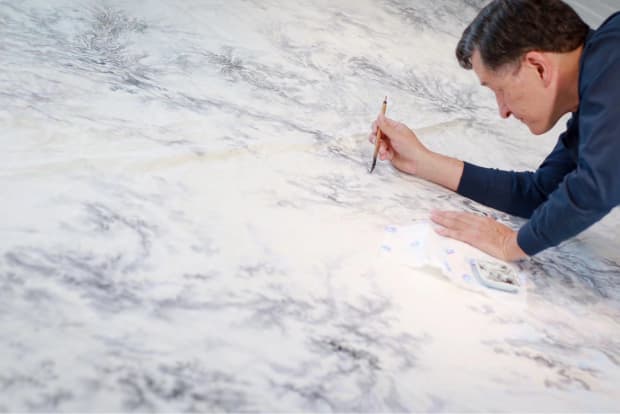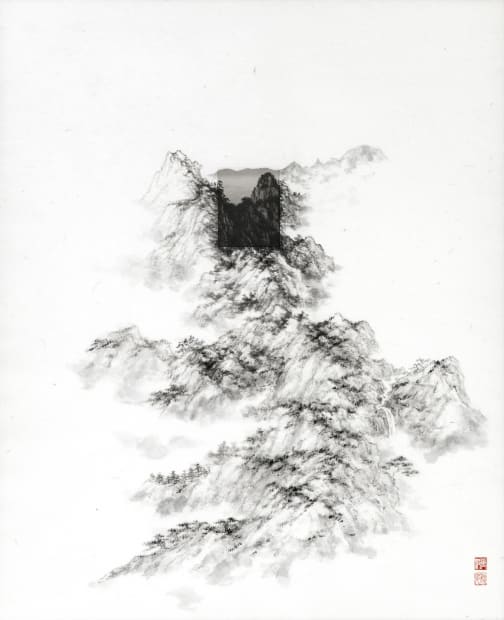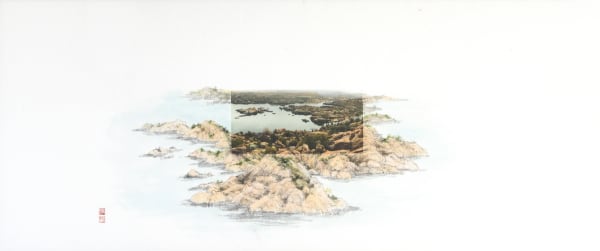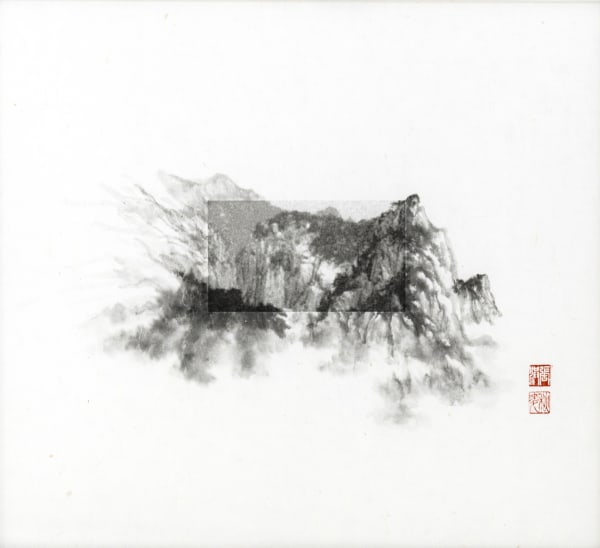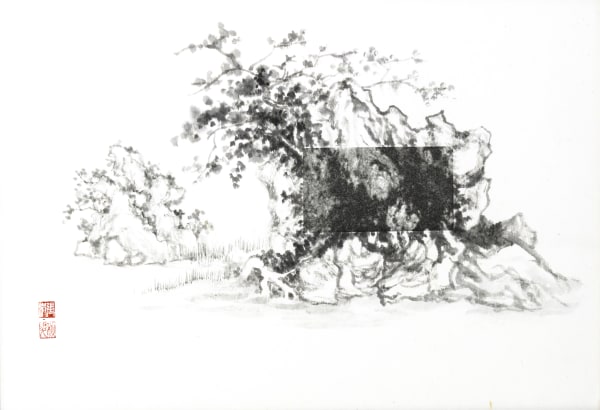-

-

-
Michael Cherney is a Jewish-American photographer who has spent most of his adult life in China. Arnold Chang is a Chinese-American ink painter of Chinese and Scottish ancestry who lives in New Jersey. While both artists come from starkly different cultural traditions, each is deeply concerned with the history of Chinese visual culture and drawn to create works rooted in the centuries-old tradition of Chinese painting.
Chang and Cherney began collaborating in 2009. Their work blurs the distinctions between photography and painting by harnessing the similarities between film grains and ink dots. This new series, neither solely photographs nor paintings but a dialogue between two artists, working in different media, embraces and reaffirms the classical aesthetics of Chinese landscape art while challenging the public's definition of shuimo 水墨 (“ink painting”).
-
-

Arnold Chang & Michael Cherney, Da Ming Mountain Study 大明山草稿 #2, 2021, photography and ink on xuan paper mounted on paper, 29 1/2 x 24 in (74.9 x 61 cm)
-
 Arnold Chang & Michael Cherney, Mount Hua 華山 #2, 2018, photography and ink on xuan paper mounted on paper, 24 x 39 in (61 x 99.1 cm)
Arnold Chang & Michael Cherney, Mount Hua 華山 #2, 2018, photography and ink on xuan paper mounted on paper, 24 x 39 in (61 x 99.1 cm)By contrast, Arnold Chang works in the opposite direction. After receiving Cherney’s carefully edited excerpts, Chang creatively expands each detail with carefully chosen and sometimes novel brushwork until he achieves a harmonious composition. Key to this process is Chang’s years of landscape painting training and his corollary skill at identifying Cunfa, or “texture strokes.” Classical Chinese painters developed the Cunfa system to depict details of the natural world, particularly the distinctive features of rocks and trees. Specific brushwork techniques were formally associated with particular textures, eventually becoming a stylistic schema that the well-informed viewer might recognize, such as a “Mi-Fu” or a “Li Tang axe-cut stroke.” But rather than imitating these granular textural patterns, Chang employs complementary brushwork and sometimes develops unique techniques such as salt-painting, to respond to each excerpt. The result is a rather witty visual conversation between two diaspora artists, living on opposite sides of the planet and working in different media, who share a deep interest in traditional Chinese history and culture and a common framework of art historical references.
-
-
Each collaborative work that Arnold Chang and Michael Cherney create is unique. Some appear as an homage to the brushwork of the old masters of Chinese art history. Others are more experimental, exploring variations in Eastern and Western painting techniques and perspectives and a range of forms of artistic production and reproduction.
As two American-born artists living and working in parallel diaspora communities, Arnold Chang and Michael Cherney are simultaneously "outsiders" and "insiders" to both the American and Chinese art worlds. Perhaps a reflection of their personal struggles to reconcile identity and ethnicity, their collaborative work is a study in achieving balance; between the East and the West, the modern and the traditional, the natural and the abstract, and the original and the reproduced. By engaging these seemingly contradictory positions, Chang and Cherney invite their viewers to do the same. They invite us to transcend the historical limitations placed on what constitutes and who produces “Chinese” and “American” art and to discover a more nuanced and global perspective, where notions of being and belonging are fundamentally fluid.
Chang and Cherney’s collaborations have been exhibited internationally, including at the Metropolitan Museum of Art, the Asian Art Museum of San Francisco, the Cleveland Museum of Art, the Kalamazoo Institute of Art, the Crow Museum, the Hong Kong Museum of Art, and the UC Santa Barbara Art, Design, and Architecture Museum.
-
-

Arnold Chang & Michael Cherney, Landscape After Wang Jiqian #2, 2021, photography and ink on xuan paper mount on paper, 24 x 56 in (61 x 142.2 cm)
-

Arnold Chang & Michael Cherney, Mountain Depths 山深 #1, 2019, photography and ink on xuan paper mount on paper, 18 x 48 in (45.7 x 121.9 cm)
-
-
AFTER GUO XI’S DEEP VALLEY: The photographic excerpt depicts abstract details of a mountain face in the Kunlun Mountains, not far from Kashgar. In his decades of travel photography, the Kunlun Mountains were the only location where Michael Cherney encountered this particular formation and texture of stone. The pattern of interlocking fissures depicted in the photo is reminiscent of a work in the Shanghai Museum by the Song dynasty painter Guo Xi. Chang referenced the painting by emulating Guo’s brush method and compositional structure.
SALT BLOOM: The “salt print” was one of the earliest processes for producing positive photographic images on standard drawing paper. The photographer wet the paper sheet with a salt solution to make it light-sensitive. In homage to this process, Michael Cherney photographed salt crystals dissolving under a microscope. He enlarged the image details to highlight the crystals’ unique structure. When printed, the crystal's fractal qualities are enhanced, often taking on the appearance of rocks, flowers, or other natural forms. Although not skilled as a flower painter, Arnold Chang couldn’t resist harmonizing his brushwork with the salt crystals’ natural floral patterns. And rising to Michael’s challenge, Chang developed a novel technique that combines Himalayan black salt with the more conventional ink medium to further enhance the crystals’ resemblance to flower blossoms.
-
-

Arnold Chang & Michael Cherney, Salt Lattice 盐图晶格, 2018, photography and ink on xuan paper mounted on paper, 24 inches x 57 inches (61 cm x 145cm)
-
 Details of Inversion #2i / #2ii
Details of Inversion #2i / #2ii -
Inversion #2i / #2ii:
This pair of works share the same photographic excerpt, a view of Granite Dells and Watson Lake in Prescott, Arizona. For Inversion 2ii, Michael Cherney “inverted” the hue by flipping the photograph's colors to their spectrum opposites. The true reds and greens of nature seen in Inversion 2i become otherworldly tints of blue and purple in Inversion 2ii. Before creating these pieces, Arnold Chang experimented with a similar blue and purple color palette in his solo works. These experiments inspired Cherney to adjust the hue of his photographs, and he was delighted to discover Chang’s color palette naturally appearing at the opposite end of the spectrum. Although the photos depict the same scene in opposite colors, Chang reacted to the inverted color schemes by imagining two separate, though related, compositions.
-
-
Huang Shan Passages series:
All of the photographic excerpts in the Huang Shan Passages series were drawn from a single 35 mm film frame of Huang Shan (Yellow Mountain) in China’s Anhui province. For each work, Cherney enlarged a unique photographic detail to the point of abstraction. His goal was to evoke nature's fundamental structures and reference the classical brushwork they inspired. In some cases, Chang rotated the original images to create vertical compositions.
-

“I can liken our collaborations to the shape of an hourglass: the vast expanse of the physical world being drawn into the lens and then further reduced to a small, grainy excerpt; focusing attention on the neck, that narrowest point, the shared stem– the moment where our arts meet and communicate. We search for resonance between artistic practices as well as between the physical and imagined world. These worlds mirror each other; any tension between them is balanced.” — Michael Cherney
-
-
 Arnold Chang & Michael Cherney, After Guo Xi's Deep Valley 仿郭熙的幽谷圖, 2019
Arnold Chang & Michael Cherney, After Guo Xi's Deep Valley 仿郭熙的幽谷圖, 2019 -
 Arnold Chang & Michael Cherney, After Xiao Yuncong 仿萧云从, 2019
Arnold Chang & Michael Cherney, After Xiao Yuncong 仿萧云从, 2019 -
 Arnold Chang & Michael Cherney, Angles 角度 #2, 2020
Arnold Chang & Michael Cherney, Angles 角度 #2, 2020 -
 Arnold Chang & Michael Cherney, Autumn 秋季, 2021
Arnold Chang & Michael Cherney, Autumn 秋季, 2021 -
 Arnold Chang & Michael Cherney, Da Ming Mountain Study 大明山草稿 #2, 2021
Arnold Chang & Michael Cherney, Da Ming Mountain Study 大明山草稿 #2, 2021 -
 Arnold Chang & Michael Cherney, Huang Shan Passages 黄山窥 #10, 2021
Arnold Chang & Michael Cherney, Huang Shan Passages 黄山窥 #10, 2021 -
 Arnold Chang & Michael Cherney, Huang Shan Passages 黄山窥 #11, 2021
Arnold Chang & Michael Cherney, Huang Shan Passages 黄山窥 #11, 2021 -
 Arnold Chang & Michael Cherney, Huang Shan Passages 黄山窥 #12, 2021
Arnold Chang & Michael Cherney, Huang Shan Passages 黄山窥 #12, 2021 -
 Arnold Chang & Michael Cherney, Huang Shan Passages 黄山窥 #4, 2021
Arnold Chang & Michael Cherney, Huang Shan Passages 黄山窥 #4, 2021 -
 Arnold Chang & Michael Cherney, Huang Shan Passages 黄山窥 #5, 2021
Arnold Chang & Michael Cherney, Huang Shan Passages 黄山窥 #5, 2021 -
 Arnold Chang & Michael Cherney, Huang Shan Passages 黄山窥 #7, 2021
Arnold Chang & Michael Cherney, Huang Shan Passages 黄山窥 #7, 2021 -
 Arnold Chang & Michael Cherney, Huang Shan Passages 黄山窥 #8, 2021
Arnold Chang & Michael Cherney, Huang Shan Passages 黄山窥 #8, 2021 -
 Arnold Chang & Michael Cherney, Huang Shan Passages 黄山窥 #9, 2021
Arnold Chang & Michael Cherney, Huang Shan Passages 黄山窥 #9, 2021 -
 Arnold Chang & Michael Cherney, inversion 倒影 #2i, 2020
Arnold Chang & Michael Cherney, inversion 倒影 #2i, 2020 -
 Arnold Chang & Michael Cherney, Inversion 倒影 #2ii, 2019
Arnold Chang & Michael Cherney, Inversion 倒影 #2ii, 2019 -
 Arnold Chang & Michael Cherney, Landscape After Wang Jiqian #2, 2021
Arnold Chang & Michael Cherney, Landscape After Wang Jiqian #2, 2021 -
 Arnold Chang & Michael Cherney, Mount Hua 華山 #2, 2018
Arnold Chang & Michael Cherney, Mount Hua 華山 #2, 2018 -
 Arnold Chang & Michael Cherney, Mountain Depths 山深 #1, 2019
Arnold Chang & Michael Cherney, Mountain Depths 山深 #1, 2019 -
 Arnold Chang & Michael Cherney, Salt Bloom 盐花, 2021
Arnold Chang & Michael Cherney, Salt Bloom 盐花, 2021 -
 Arnold Chang & Michael Cherney, Saltscape Lattice 盐图晶格, 2018
Arnold Chang & Michael Cherney, Saltscape Lattice 盐图晶格, 2018 -
 Arnold Chang & Michael Cherney, Scholartree 槐, 2019
Arnold Chang & Michael Cherney, Scholartree 槐, 2019
-
-
More about Artists
The Collaborative Works of Arnold Chang and Michael Cherney, 18 March - 7 May 2022
Join our mailing list
* denotes required fields
We will process the personal data you have supplied to communicate with you in accordance with our Privacy Policy. You can unsubscribe or change your preferences at any time by clicking the link in our emails.


